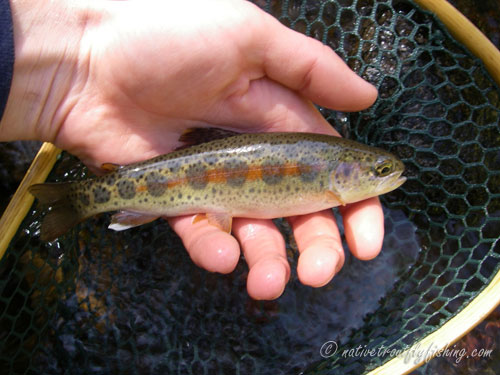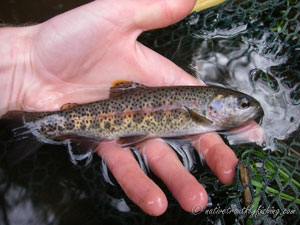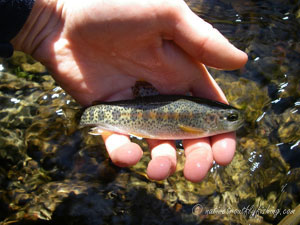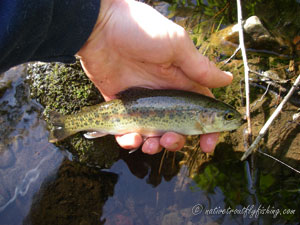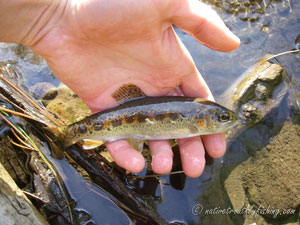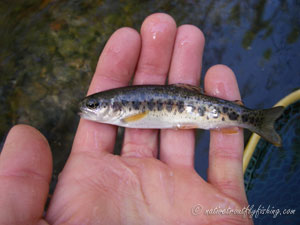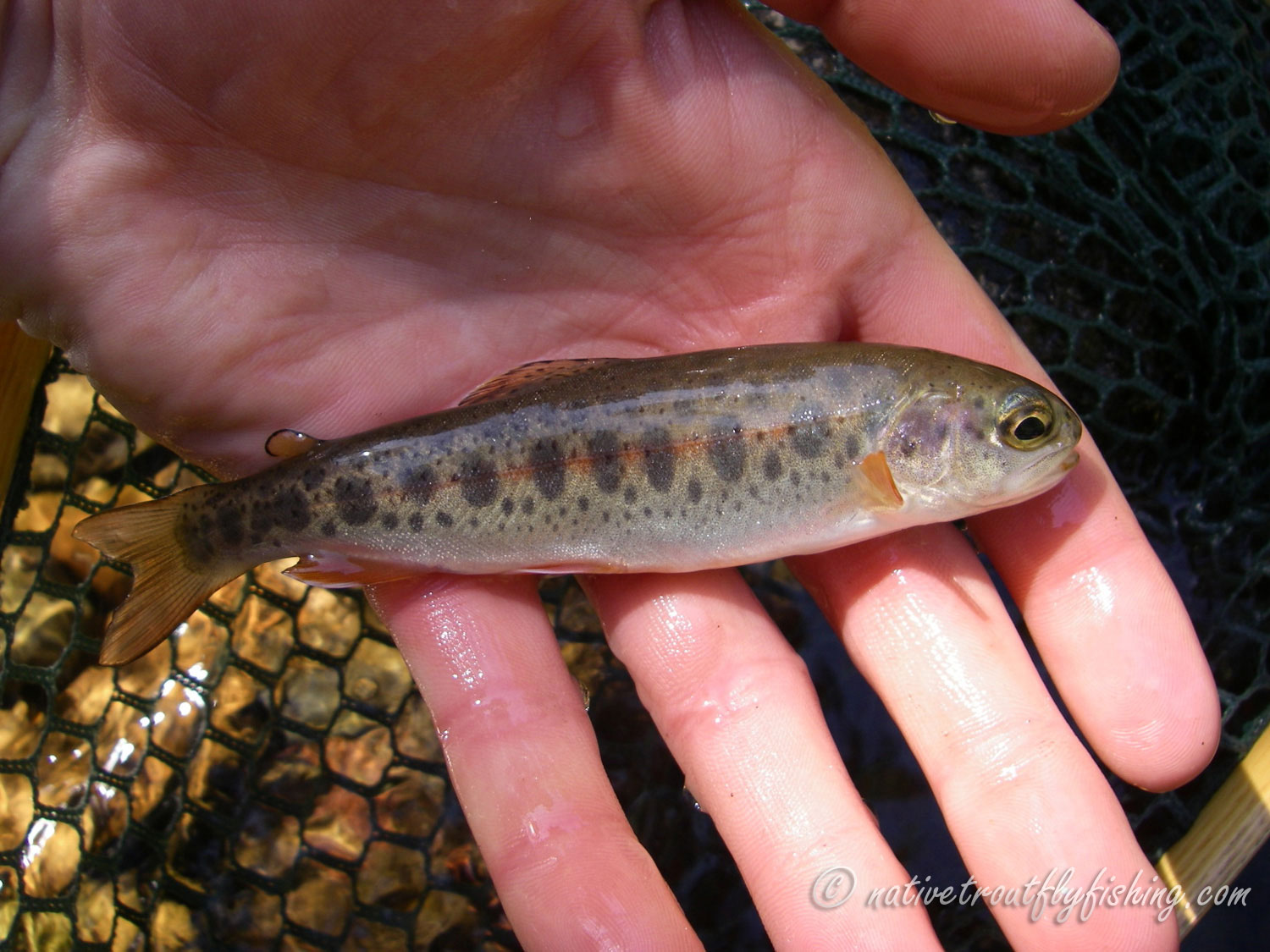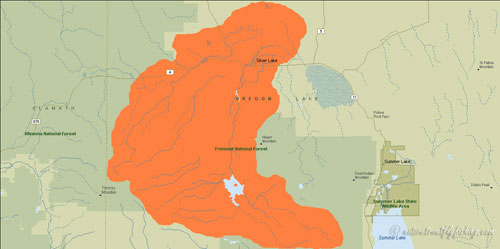Fort Rock Basin Redband
Oncorhynchus mykiss ssp.
A Fort Rock Basin Redband from a small Oregon stream
Introduction
The Fort Rock Basin redband trout are native to three streams (Silver, Bridge and Buck Creeks) in the Fort Rock Basin of central Oregon. The Fort Rock Basin once drained to the Columbia River via the Deschutes River, and while they are related to Columbia Basin redbands, Fort Rock Basin redbands are genetically distinct, indicating that they have been isolated from the Columbia Basin for a significant amount of time (Currens et al. 2009). Fort Rock redbands also have some traits in common with Klamath Basin redbands, suggesting that a headwater connection to the Upper Klamath basin existed in the past (Behnke 2002, Behnke 2007, Currens et al. 2009).
Life History Information
Like other internal basins in Oregon, the Fort Rock basin was once filled with a large lake during the Pleistocene era, but all that remains today are Silver Lake and Paulina Marsh. Historically Paulina Marsh had the ability to support adfluvial redbands, but this life history type was eliminated when the marsh was drained for agricultural use when the area was settled (ODFW 2005). Currently the only suitable habitat for trout are the basin's three small streams and as such, these redbands exhibit a stream resident life history. These fish feed primarily on aquatic and terrestrial insects and typically attain a maximum size of around 12" at around three to five years old (Behnke 2002).
Status
The United States Fish and Wildlife Service received petitions to list Redband trout in 1994, 1995 and 1997, all of which have been denied (Rhew 2007). Despite not being formally listed the Oregon Department of Fish and Wildlife considers them to be at risk of extinction, due to the limited habitat that they occupy (ODFW 2005). The threats to these fish today are similar to those affecting other Oregon redband populations, with habitat destruction and the introduction of non-native fish being the primary problems. Of the three streams in the basin, Silver Creek has been the most affected by introductions of non-native fish. Hatchery rainbow trout and brook trout were extensively stocked in the creek and have replaced the redbands throughout most of the drainage (ODFW 2005). According to Behnke (1992), fish that he sampled in the basin in the 1980’s showed a slight hybrid influence with hatchery rainbow trout. In the streams devoid of brook trout the average lengths and densities of Fort Rock Basin redband trout were larger and higher compared to those where brook trout have been introduced, suggesting that competition with brook trout is impacting redband trout populations to some extent (Miller et al. 2014). However, trout densities overall were higher in streams with both brook and redband trout, likely indicating that the two species are utilizing slightly different habitat.
Habitat destruction has also led to declines of Fort Rock redbands. Paulina Marsh once provided an important rearing habitat for adfluvial redbands, but was drained for agricultural use, leading to the elimination of this migratory life history. Upstream from the marsh, grazing and logging have degraded the quality of the habitat, leading to erosion, incising of the stream channel sedimentation and destruction of riparian vegetation. This has resulted in loss of channel complexity, warmer water temperatures and the degradation of vital headwater spawning habitat.
Description
Fort Rock Basin redband trout are olive or bronze on the back, which transitions to a yellowish color across the body with a pink to brick red color along their lateral line and on their gill plates. The spotting pattern consists of small irregular shaped spots that are distributed above and below the lateral line and on the caudal and dorsal fins. Purplish colored elliptical shaped parr marks are often retained into maturity. The caudal fin is forked and the dorsal fin may be tipped with either orange or white and the lower fins are an orange color tipped with white.
Stream Resident Form
Click on images to view a larger picture
Native Range
A map of the native range of the Fort Rock basin redband trout. Data Sources: Behnke (2002) and ODFW (2005).
References
Behnke, R. J. 1992. Native trout of western North America. American Fisheries Society Monograph 6. American Fisheries Society, Bethesda, Maryland.
Behnke, R.J. 2002. Trout and Salmon of North America. Chanticleer Press, New York.
Behnke, R.J. 2007. Redband trout of the Northern Great Basin. Pages 1–9 in R. K. Schroeder and J.D. Hall, editors. Redband trout: resilience and challenge in a changing landscape. Oregon Chapter, American Fisheries Society, Corvallis.
Currens, K.P., C.B. Schreck and H.W. Li. 2009. Evolutionary ecology of redband trout. Transactions of the American Fisheries Society 138: 797–817.ODFW. 2005. Oregon native fish status report. Oregon Dept. of Fish and Wildlife, Salem, OR.
Miller, S.A., S. Gunckel, S. Jacobs and D.R. Warren. 2014. Sympatric relationship between redband trout and non-native brook trout in the Southeastern Oregon Great Basin. Environmental Biology of Fishes 97(4): 357-369.
ODFW. 2005. Oregon native fish status report. Oregon Dept. of Fish and Wildlife, Salem, Oregon.
Rhew, R. 2007. Redband trout and the Endangered Species Act. Pages 123-126 in R. K. Schroeder and J.D. Hall, editors. Redband trout: resilience and challenge in a changing landscape. Oregon Chapter,American Fisheries Society, Corvallis.
Contact
Feel free to contact me if you have any questions or comments
Fort Rock Redband Trout Links
Oregon Department of Fish and Wildlife - Redband Trout
Western Native Trout Initiative - Redband Trout
Native Trout Links
Truchas Mexicanas' - Native Trout of Mexico
Balkan Trout Restoration Group
Trout and Seasons of the Mountain Village - About Japanese Trout
Western Native Trout Challenge
California Heritage Trout Challenge
Fly Fishing Blogs
Dave B's Blog: Fly Fishing for Native Trout
The Search for Native Salmonids
Conservation Links
Western Native Trout Initiative
Fly Fishing Links
Fishing Art Links
Americanfishes.com - Joseph R. Tomelleri
Fish Eye Guy - Underwater Trout and Salmon Pictures
